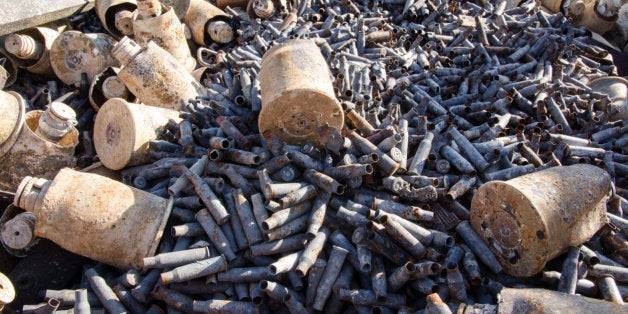
Between the borders of Syria and Jordan is a no-man's land several miles across called the Berm, where 70,000 refugees are trapped in appalling conditions.
Little reported because aid agencies do not want to antagonise Jordan, which has taken in almost a million Syrian refugees, the Berm is supplied with food, water and medical supplies partly as a result of philanthropists' collaboration with government.
Last year, Canada announced it would match any funds donated to help Syrians, but the campaign had elicited only around $9million USD by the deadline at the end of December, when philanthropists started to take the lead in the campaign.
What we're interested in is adding value beyond our money
While making a sizeable donation, the Houssian Foundation asked the government for an extension in which to mobilise others. After a further eight weeks, the total had reached $24million USD, which the Canadian government matched. Some of that money went to alleviating conditions in the Berm, including setting up 'Makani' centres where refugee children get education and psychological support.
Jessica Houssian, one of the Foundation's directors, told Apolitical, 'What we're interested in is working in a way that adds value beyond our money. So in this case it was about connecting with the community to leverage resources, not only the government's but also the private sector's, and raise awareness that leads to even more.'
The Foundation is now working with the Canadian state to figure out how they can co-operate more closely in future. Houssian said, 'There's a role for each of us and what we need to understand is: what's the common agenda? And then: how can everyone operate at their highest and best to leverage each other?'
This collaboration is part of a trend shaking things up all over the world: governments and philanthropists are turning to each other to tackle problems that neither could attempt alone. A new model of how to do that has been invented by the Maverick Collective, a group of women philanthropists co-chaired by Melinda Gates and the Crown Princess of Norway.
The philanthropists like to be part of the solution
As is often the case in collaborations of this sort, the Maverick Collective can pay for pilot projects that carry too high a degree of risk for government to bear. If the pilots succeed, they can be scaled up by governments or institutions like DFID and USAID.
What makes the Maverick Collective different is that the philanthropists lend their skills and contacts to their chosen field. One who had run an agency specialising in human-centred design for firms like Nike and Levi's used the same techniques to improving a teen pregnancy project in Tanzania.
'She helped us look at how we were designing interventions,' said Kate Roberts, one of the Collective's co-founders. 'Due to her involvement, we got further partnerships for other countries in what is now a $30million project. Because of her skills and the results we could show, it's now in Ethiopia and Nigeria.'
Roberts added, 'Philanthropists like it because it goes beyond check writing. They roll up their sleeves and are part of the solution.'
For governments, the appeal is partly that philanthropy will work almost like a venture capital fund, bearing a high degree of risk. The other part is the sheer scale of the problems that need to be solved. There is a shortfall estimated at between two and three trillion dollars annually in achieving the Sustainable Development Goals to which UN member states have committed.
That shortfall is being made up through things like USAID's Global Development Alliance, which matches state funds to private and corporate donations. Since its inception in 2001, it has created more than 1,500 partnerships and mobilised well over a billion dollars.
Domestically as well, the squeeze is on. Government budgets have been severely cut since 2008, and foundations have also seen the growth of their assets slow down since the golden era of the 1990s, at the end of which many also lost out heavily when the dotcom bubble burst.
Fred Ali, board chairman at The Center on Philanthropy and Public Policy, has said, 'I don't think I've ever seen a more challenging time in philanthropy.'
So the response has been to try and forge ongoing partnerships rather than ad-hoc collaborations in moments of crisis. In the US, for example, there has been a proliferation of Offices of Strategic Partnership since the oldest surviving one opened in 2003, in Michigan. Run as part of the governor's office, it was actually set up on the initiative of philanthropists and with their support. A variant of these OSPs is that foundations are increasingly funding staff within government to bridge the divide, usually in a certain topic such as education.
The head of the Michigan office, Karen Aldridge-Eason, told Apolitical, 'Government and philanthropy don't speak the same language. And so these offices are about being able to translate, being able to broker between the two, and have relationships in both worlds to build a bridge so that work can be done.
'It's hard work, because often people say, yeah, we want to collaborate, but then they don't want to move from where they are. So I try to make sure they have early conversations and build things together. It's not good for a state to build a project and then ask foundations to fund it. Because foundations have read the research, they know the evidence and they have their own ideas about how it should be done.
Is there anybody out there who knows something about this?
'If a foundation wants to collaborate with the state government, there are 16 departments and 30-something thousand employees. So it's for them to be able to say: I don't know where to go but this is an issue that I want to talk to somebody about, or vice versa. Or for the state government it could just be: is there anybody out there who knows something about this issue we're working on?
'We help government understand that it's not always about monetary help; it's about the knowledge that foundations can bring.'
The main difficulty for offices of this sort has been surviving changes of administration, because even though the work is supposed to be non-partisan, it is so closely associated with individuals that offices or their staff are often ejected with outgoing mayors or governors. The other difficulties are that governments can try to treat philanthropists like ATM machines, without consulting their knowledge, or that foundations don't understand government's obligations to, say, pass legislation in support of an initiative or pay for things at certain points in the budget cycle.
Nevertheless, the Michigan office, just to take one example, has brokered more than $100million of investment in fields such as education, health and early childhood development.
They can do more once the relationships are built
As these relationships continue to develop, the real value goes far beyond cash. Sophisticated collaborations between not just government and philanthropy, but also socially responsible business and NGOs with detailed local knowledge can mobilise far greater resources of money, manpower and expertise than anything they could hope to achieve by themselves.
Professor James Ferris, founding director of the Center on Philanthropy and Public Policy at the University of Southern California, told Apolitical, 'It is not just philanthropy, but business as well. They do a lot of information sharing between the sectors and over time move to more joint developments. They can do more once the relationships are built, and there is common understanding.'
Nevertheless, there is a mountain to climb. That trillion-dollar funding gap for the Sustainable Development Goals will not be plugged easily, and even the UN response to a high-profile crisis like the war in Syria has a shortfall of $789million in this year's budget. In the developed world, also, there is long-standing economic stagnation and increasing job insecurity. The challenges facing any combination of government, philanthropy, NGOs and private business are sobering.
But as Karen Aldridge-Eason told Apolitical, 'You know, we care about the same things, we care about healthy communities, about kids getting a good education, about citizens returning home from prison and being successful, we care about folks developing the skills they need to be n the workforce, so if we care about the same things, maybe we should work on them together rather than separately.'
